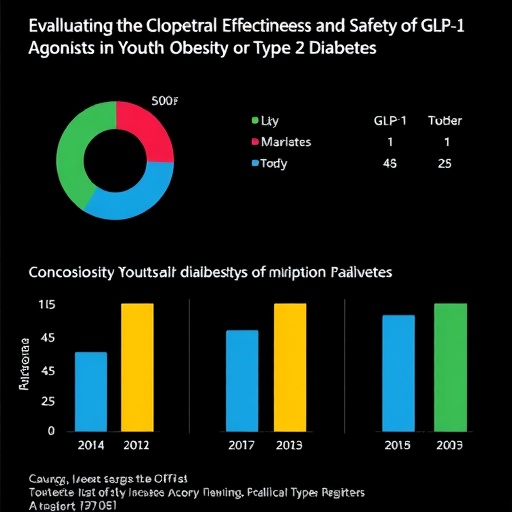A comprehensive systematic review and meta-analysis published in JAMA Pediatrics has shed new light on the efficacy of glucagon-like peptide-1 receptor agonists (GLP-1 RAs) in managing pediatric metabolic disorders, particularly in children and adolescents grappling with type 2 diabetes and obesity. The study, which pooled data from 18 randomized controlled trials, highlights significant improvements in glycemic control, body weight regulation, and cardiometabolic health among the youth cohort treated with GLP-1 receptor agonists. These findings underscore the expanding therapeutic role of GLP-1 RAs beyond adult populations, addressing critical gaps in pediatric metabolic disease management.
GLP-1 receptor agonists are a class of incretin-based therapies that amplify glucose-dependent insulin secretion. Their mechanism of action hinges on mimicking the endogenous hormone GLP-1, which modulates several physiological pathways including appetite suppression, gastric emptying delay, and pancreatic beta-cell function. This molecular mimicry facilitates enhanced insulinotropic effects and contributes to weight loss — two pivotal factors in combating the pathophysiology of type 2 diabetes and obesity. Within pediatric populations, the translational adoption of GLP-1 RAs necessitates robust evidence due to distinct developmental and metabolic dynamics compared to adults.
The meta-analytic synthesis incorporated data from trials with follow-up periods that, while relatively brief, consistently demonstrated favorable outcomes. Glycemic parameters, notably HbA1c levels and fasting glucose, revealed significant reductions across studies involving GLP-1 RA administration. Such glycemic improvements are clinically meaningful, given the aggressive progression and early onset of complications observed in youth-onset type 2 diabetes. Moreover, weight loss effects were prominent, marking GLP-1 RAs as a dual-action intervention targeting both hyperglycemia and obesity — a comorbid tandem frequently seen in pediatric metabolic syndrome.
Aside from metabolic benefits, the analysis extended into cardiometabolic domains, an area often overshadowed in metabolic research. Adolescents with type 2 diabetes and obesity face increased cardiovascular risk, including hypertension, dyslipidemia, and endothelial dysfunction. The study reports that GLP-1 RA therapy imparted improvements in lipid profiles, blood pressure metrics, and surrogate markers of atherosclerosis, hinting at early cardioprotective advantages. These findings align with adult cardiovascular outcomes observed in major GLP-1 RA trials but are groundbreaking for pediatric intervention strategies.
Despite encouraging therapeutic potential, safety considerations remain paramount, especially within pediatric cohorts. The systematic review meticulously examined adverse event profiles, noting a consistent pattern of gastrointestinal side effects such as nausea, vomiting, and diarrhea. These symptoms, while anticipated based on GLP-1 RA pharmacodynamics, necessitate careful long-term management strategies to optimize adherence and clinical outcomes. Importantly, the pooled data suggested no significant increase in suicidal ideation or behaviors, a concern previously raised regarding some incretin-based therapies. Nonetheless, ongoing vigilance is advised given the limited duration of current studies.
The implications of this aggregated evidence are far-reaching. Pediatric endocrinology has historically faced challenges in expanding effective pharmacotherapies approved for children with metabolic disorders. GLP-1 RAs may represent a paradigm shift, affording clinicians a novel tool to combat early metabolic dysregulation — a condition that portends severe health sequelae in adulthood. Furthermore, the dual benefit on weight and glycemic control uniquely positions GLP-1 RAs to address the intertwined pathological mechanisms in youth metabolic diseases.
Further research must prioritize extended follow-up durations to delineate the long-term safety, durability of glycemic and weight outcomes, and potential impacts on growth and development. Investigating the interplay between GLP-1 receptor activation and the pediatric endocrine milieu may elucidate mechanisms driving variable responses among youth. Additionally, exploring patient-reported outcomes and quality-of-life measures is crucial to comprehensively evaluate the therapy’s role in clinical practice.
From a mechanistic standpoint, the receptor agonists stimulate cyclic AMP production within pancreatic beta cells, enhancing glucose-dependent insulin release while also modulating glucagon secretion. This endocrine balancing act helps circumvent hypoglycemic episodes frequently encountered with traditional therapies. In parallel, GLP-1 RAs slow gastric emptying, contributing to decreased postprandial glucose excursions and promoting satiety signals within the hypothalamus, correlating with the observed weight loss. These multi-faceted effects integrate systemic metabolic control with appetite regulation, crucial for effective obesity management in children and adolescents.
A key challenge remains in balancing efficacy with tolerability. Gastrointestinal adverse effects, often dose-dependent, may impair compliance. Emerging formulations and dosing regimens aim to mitigate these events, enhancing patient acceptability. Furthermore, personalized medicine approaches leveraging genetic and metabolic biomarkers may optimize therapeutic selection, maximizing benefit while minimizing side effects.
Economic and accessibility considerations also play a critical role in the implementation of GLP-1 RAs in routine pediatric care. Currently, these agents present cost and insurance barriers, particularly in under-resourced settings where the burden of pediatric obesity and diabetes is rising disproportionately. Policy initiatives and healthcare frameworks must adapt to integrate these advancements equitably.
In conclusion, this meta-analysis provides compelling evidence for the integration of GLP-1 receptor agonists into the therapeutic landscape for pediatric type 2 diabetes and obesity. Their multi-dimensional benefits on glycemic control, weight reduction, and cardiometabolic health offer a promising strategy to curb the escalating public health challenges posed by early metabolic dysfunction. Emphasizing long-term safety monitoring and addressing implementation barriers will be crucial in translating these findings into widespread clinical impact.
Subject of Research: Pediatric type 2 diabetes and obesity management using glucagon-like peptide-1 receptor agonists (GLP-1 RAs)
Article Title: Systematic Review and Meta-Analysis of GLP-1 Receptor Agonists in Children and Adolescents with Type 2 Diabetes or Obesity
News Publication Date: Not specified
References: (doi:10.1001/jamapediatrics.2025.3243)
Keywords: Agonists, Peptides, Type 2 diabetes, Children, Adolescents, Cardiology, Metabolic health, Behaviorism, Suicide, Adverse effects, Gastrointestinal disorders, Pediatrics, Body weight, Obesity, Data analysis




